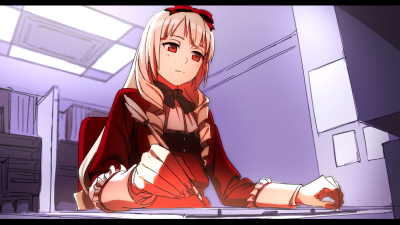I read this and I don’t get what the other end of the spectrum is. And to be fair, aren’t we all Evirus wannabes? Who are these exceptions?
Some incidental spoilers on Shirobako ahead. It’s not a post about Shirobako so I didn’t think it’s a big deal.
And here is where I make a point about diversity of voices versus the blogger’s need to entertain. I think ultimately the kind of discourse that goes into, say, the pre-production meetings (that Author should have a field day with, but hasn’t gotten to cour #2 yet) and the generalities behind large-scale artistic endeavors should cut in all sorts of ways, in a variety of different dimensions. It should not be surprising to see Kinoshita talk about Arupin’s core. What should be surprising is seeing the passion behind it. Or that later on how Aoi cries for the girls in the Squad. I had expected more the “type of cloud” talk, because that stuff is deep as all hell yo. The power of the art board is something nobody talks about, at least in my echo chambers. Hearing it in Shirobako was like finding that anime blogger you’ve never knew blogged anime because you want to read every word that person had to say about it. But for me to make this statement is basically stating what Author has stated, except in the positive, the personal, and in the descriptive ways, in opposite.
It’s the same reason why this is more what fans should expect out of the fruits of lovers’ labors. This is where Goripon comes in as an example. This is yet another reason why Ps generally adore Anim@s to bits.
I digress. These are not just emoji full of tears. I think a more sensitive, and constructively discoursed dialog can bring out the diversity of voices that tend to course through the less-traveled roads. This is kind of the thing reddit-ism or channer mentality makes difficult, and that feeds into the, say, video game review scores discourse or why people don’t bother with certain details. Anime, to me, is all about details. This is why discussions about “cour” or “slice of life” have a place. Because it’s the kind of thing that can matter under the wide brush of stereotypes versus genre norms. It’s why subversion works in anime (and is rather common). It’s not about how stories have to do certain things up front, because that’s the starting point. It’s about why how things are. To expand on Kancolle, as an example, the stuff it isn’t saying in the anime can speak just as much.
But that also speaks a lot more to consumerism than how anime is made. In as much as Shirobako is educational, it speaks to our ignorance (or in a lot of cases, writing about Shirobako is like letting our ignorance do the talking). And just like Kancolle, what we don’t know speaks as much as what we do. That isn’t even touching things like “perspective” in which most of us come into context of parsing reviews from reviewers. So when I read about Author’s take I appreciate that perspective. It’s one I do not have, and frankly half the time I’m not even sure where he is coming from.
This goes back to Shirobako, which Author paints a dutiful uptake at first. I wonder how much of duty in the context of fandom’s musts are closer related to Stockholm syndrome than to pure and passionate dedication simply because we like it. But when our captors are so benevolent, I guess we don’t really care? Okay, I do, but you certainly do not have to. Just like it’s okay to be Evirus; if anything, I don’t think he can’t; no more than hostages in a violent situation.

March 3rd, 2015 at 3:51 pm
I don’t want to be an Evirus of animeblogging, I want to be Instapundit of animeblogging.
March 3rd, 2015 at 6:24 pm
I don’t know what you want to be like, but it may not reflect in how others perceive your work.